Are you a lass who's fed up with the stiffness and lack of breathability of hiking boots but want something with a bit more support than your average trainer? Ah, dear reader, it seems you have stumbled into the land of the women's hiking shoe: a dreamy compromise between comfort, support, responsiveness and breathability.
Deciding on the best women's walking shoes for you can be tricky though - which is why we've rounded up some of the best on the market to choose from, no matter your use case.
What are the best women's walking shoes of 2024?
Best in test: Salewa Women's Pedroc PTX Shoe
Best value: Keen Targhee III Waterproof
Most comfortable hiking shoes: Hoka Stinson 7
Best minimalist hiking shoes: Xero Mesa Trail II
As more and more people opt for modern, lightweight hiking footwear over a heavier, stiffer walking boot, the market has grown from traditional approach-style shoes for scrambling, to all manner of low-ankle shoes designed for every type of hiking. From trail-shoe-adjacent options offering mud-bashing squishiness, to slick-backed Gore-Tex all-rounders, to more traditional leather and suede options, the choice is endless.
So, to help you make the right buying decision, our group of female testers here at LFTO have been putting various women's walking shoes to the test all over the UK and beyond, to bring you the very best tried-and-tested recommendations.
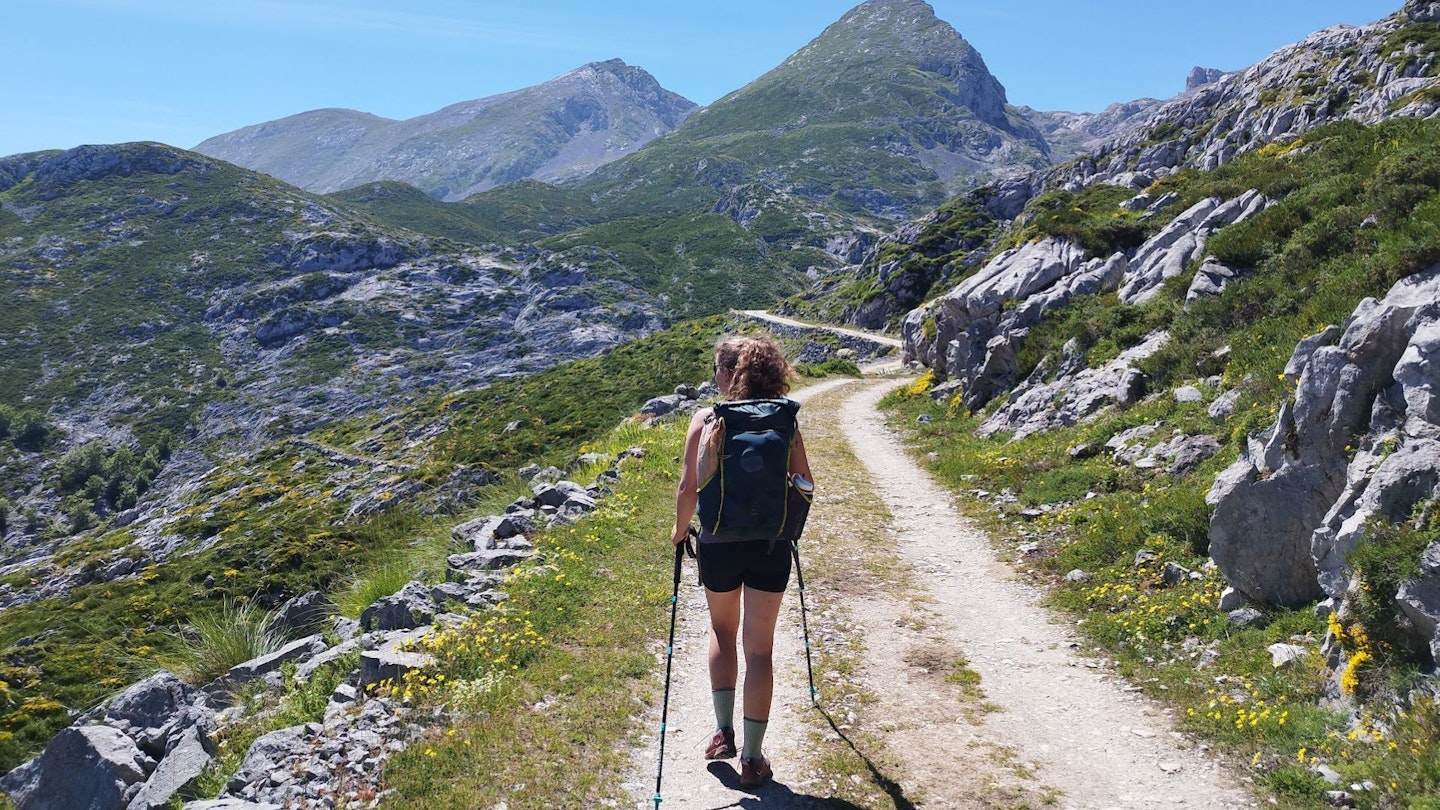
And before we get started - the difference between men and women's versions is usually down to width, with women's shoes being on the narrower side in comparison to men's. Wear what you're most comfortable with if you sizing happens to overlap.
Speaking of overlap, you’ll also notice a crossover here between the best women's walking shoes and several trail running shoe options. We believe that many trail shoes are suited to walking as well as running due to their extra cushioning, bounce and grip, but the devil's in the detail when it comes to whether they can be swapped like-for-like with hiking boots.
How we tested the best women's hiking shoes
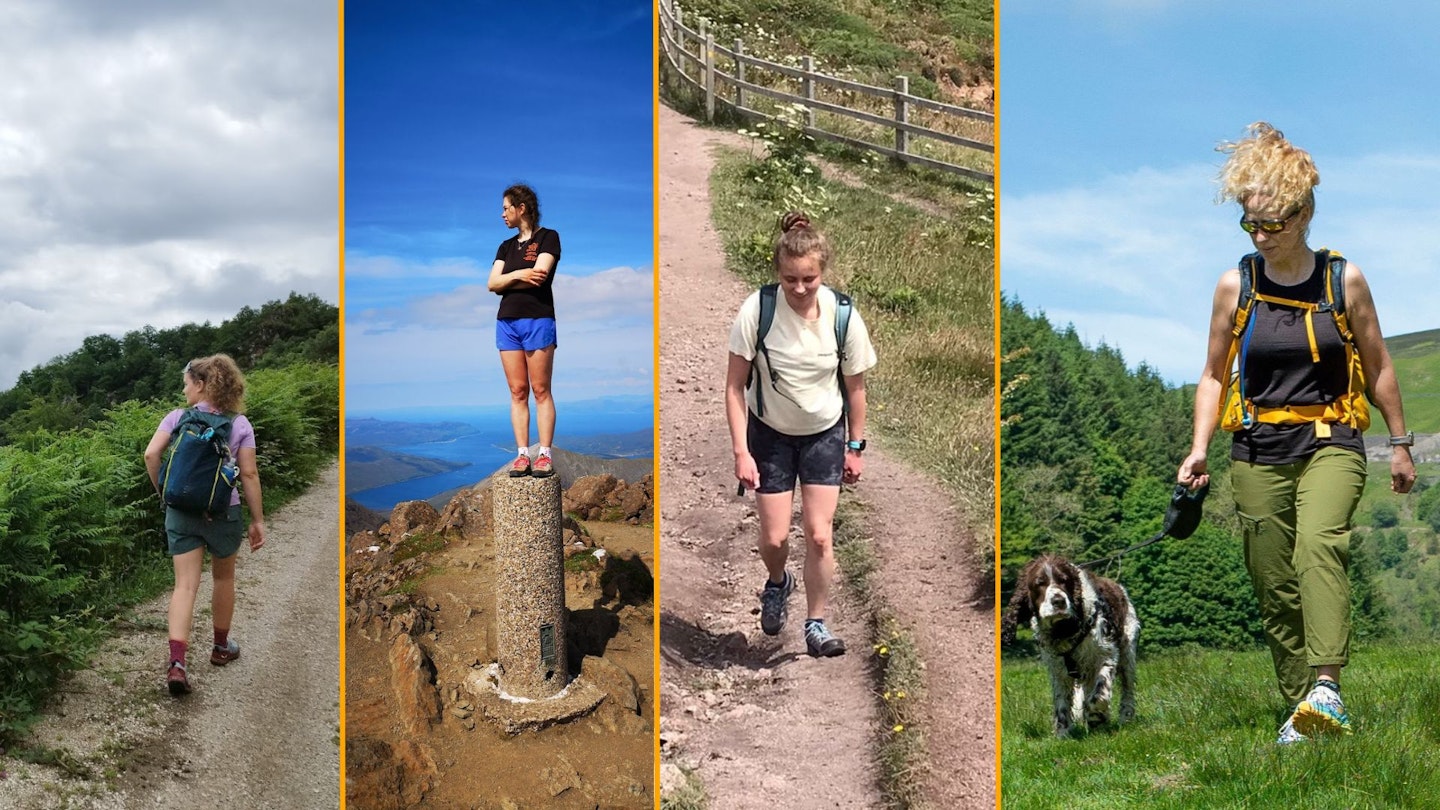
The female LFTO testing team have been hard at work to bring you the very best tried-and-tested recommendations when it comes to the best women's hiking shoes. The following reviews were written by a mix of different people: Fliss Freeborn, digital writer for LFTO, Jenna Maryniak, Deputy editor of Trail Magazine, plus freelance testers Fran Brosnahan and Rachel Collins. As a team we have a variety of different foot shapes, cushioning preferences and have tested each shoe in every corner of the UK and beyond, from Cornwall, to Wales, to the Lakes, to Scotland and the Picos De Europa in Northern Spain.
We love these all-terrain walking shoes from Salewa. They do just about everything you'd want from a walking shoe, and they do it well: fantastic grip, good responsiveness, enough cushioning to make long distances feel breezy, plus a very durable Gore-Tex upper that keeps our feet dry even in the wettest of conditions.
We tested them throughout a week of hiking in the Picos De Europas and were incredibly impressed with the fit, feel and sturdiness over steep and rocky terrain, as well as on softer forested paths. Additionally, they kept our feet completely dry in very long, very wet grass, and across various stream crossings - but on hotter days they were still incredibly breathable in comparison to other hiking shoes we've worn.
The lugs are deep and well-placed, making grassy banks and muddy surfaces an absolute breeze - in comparison with a pair of Hokas used in the same damp, forested environment, the Pedrocs outperformed them significantly, never losing traction even on the slippiest, sloppiest of routes.
We also love the materials used. Not only do the ripstop mesh upper, kevlar cabling and eyelets fro the lacing seem incredibly durable and high quality, the Pedroc is also manufactured according to independently-audited environmental and social responsibility standards with a PFC-free sustainable, waterproof membrane. Big wins for us on the ethics department.
Like most excellent hiking gear, these do not come cheap. A downside initially indeed, but the age-old mantra of buy nice, not twice, is more applicable here than almost anywhere else due to shoes having the most significant impact on your day out than any other piece of clothing. Granted, £175 (RRP) is a lot of money for a pair of shoes, but we truly believe that these will out-last many of the cheaper pairs rivals, and perform fantastically for years to come.
Pros
- Fantastic grip
- Wonderful for both walking and scrambling
- Great level of comfort - not too stiff, not too squishy
- Waterproof and breathable
- Lightweight
Cons
- Pricey
| Weight (per shoe) | 260g (Size 5 UK) |
| Upper | Synthetic w/ TPU rand and PFC-free PowerTrex waterproof lining |
| Sole | Pomoca Speed Hiker Pro |
| Women's sizes | 3-9.5 |
The Keen Targhee III Waterproof is the Sunday roast of walking shoes: a classic for a reason. The two-tone nubuck leather uppers exude quality yet the shoe is excellent value too. Although a bit chunkier than other shoes on this list, the Targhee offers remarkable support and comfort, feeling almost like a boot in terms of stability.
This is the third iteration of Keen's popular walking shoe, and features a waterproof leather and mesh upper with Keen’s own KEEN.DRY membrane, ensuring your feet stay dry while remaining breathable. The ergonomic footbed, which is removable, moulds to your foot for enhanced stability and cushioning - comfort is immediate with these shoes, thanks to their cushioned tongue and generous width, perfect for those with wider feet. There’s no need to break them in, a rare and welcome feature.
The Targhee III’s upper features a snug heel fit, providing good ankle support without heel lift. The air-injected midsole offers great shock absorption without feeling overly bouncy, though the shoe is by no means lightweight. The KEEN.RUGGED outsole is highly abrasion-resistant, offering secure grip even on tricky surfaces. The tread strikes a perfect balance between grip and versatility, making it ideal for varied terrains - we tested it on Cornish coast paths and bridleways during the UK's attempt at a summer season the excellent waterproofing was very much needed.
Keen's commitment to sustainability is impressive. The brand has eliminated PFAS from its manufacturing since 2018, use Luftcell cushioning to reduce polyurethane, and incorporate recycled PET plastic. The ethical approach is a major plus. While slightly heavy and potentially too wide for some, the performance and eco-friendly design makes the Targhee III a top pick for us here at LFTO.
Pros
- Very comfortable
- Great ankle support
- High quality materials
Cons
- Heavy
- Wide fit won't suit everyone
| Weight (per shoe) | 472g |
| Upper | Combination of leather and breathable mesh |
| Sole | TPU<strong> </strong>Outsole |
| Women's sizes | 3-7.5 |
The Hoka Stinson 7 shoe is the standout option for those prioritising long-lasting comfort and support on day-hikes, especially on harder or rockier trails. Known for its super plush cushioning, this shoe ensures maximum comfort even during extended walks over over 35km per day in tough-going places such as the Dolomites. Originally designed as a trail running shoe, it proves equally effective for long-distance trail walking, providing a bouncy, responsive feel that propels you forward with each step, saving you energy in the long run.
The Stinson 7's design includes a wider platform for enhanced stability, making every stride feel secure. The breathable mesh upper allows for adequate airflow, keeping your feet cool and dry over time; a feature we definitely needed while testing them abroad in the summer. Hoka’s signature Meta-Rocker technology promotes a smooth, natural stride, but those who are used to a more responsive ground-feel might struggle with the stack height and feeling of walking on a cloud when you're actually churning up scree.
Additionally, these are not the best for sloppier, muddier days out. You're better off looking for something more like the Salewa Women's Pedroc PTX Shoes - or something else something fully Goretx-ed, a little stiffer, and closer to the ground. And while the Stinson 7 offers a dreamy comfort level for those carrying a day pack, those hauling a significant overnight pack over boggy terrain might still find boots a more suitable option.
Overall, however, the HOKA Stinson 7 is one of the most comfortable walking shoes we've ever had the pleasure of slipping on. They're a fabulous choice for walkers who prioritise both cushioning and durability in their footwear, and enjoy the feeling of being propelled along by bouncy clouds.
Read our full Hoka Stinson 7 review
Pros
- Like wearing a hug on each foot
- Breathable mesh keeps feet cool and dry
- Bouncy feel propels you along
Cons
- Not the best for bog or wet mud
- Some people will prefer a more responsive ground feel
| Weight (per shoe) | 305g |
| Upper | Synthetic |
| Sole | Durabrasion |
| Women's sizes | 3.5-9.5 |
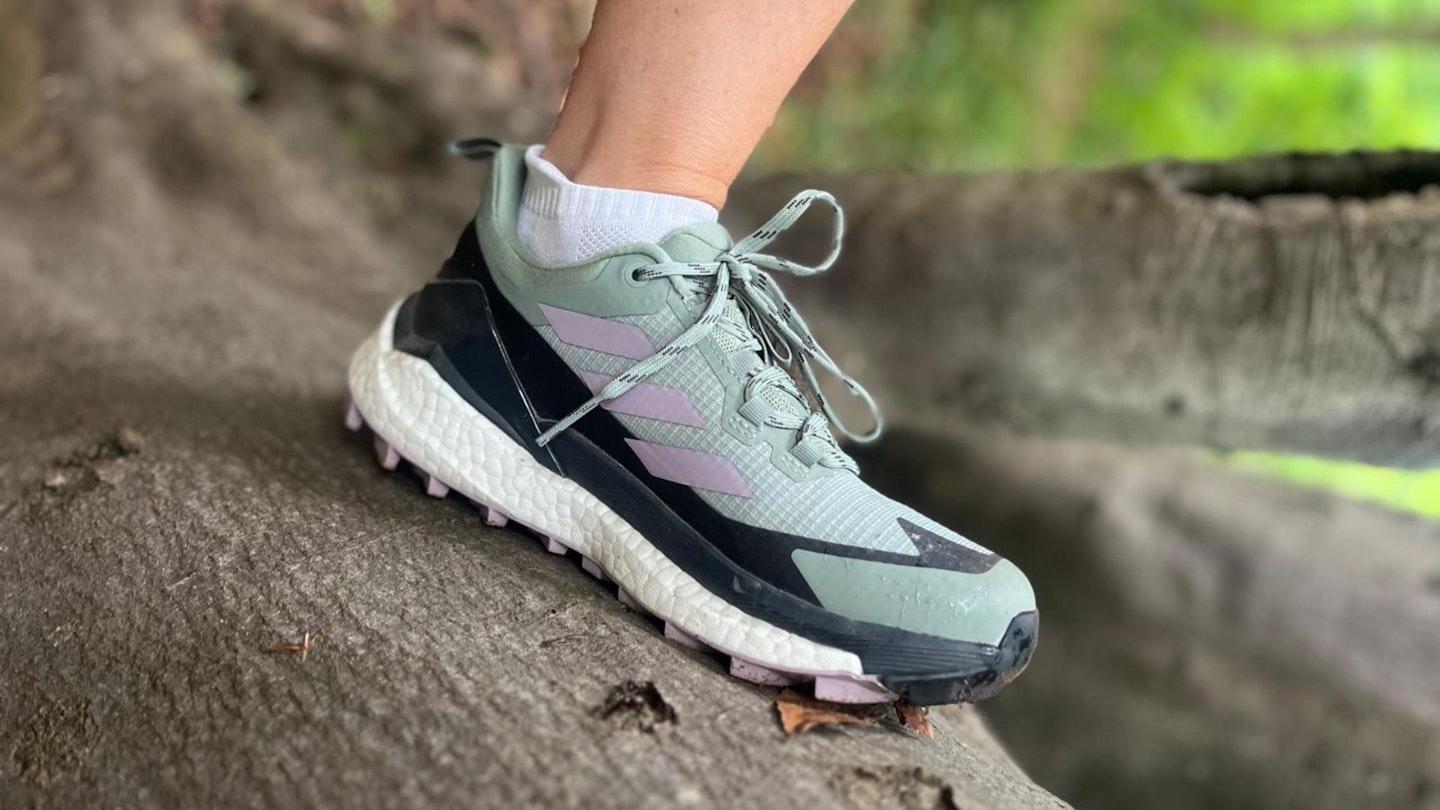 LFTO
LFTOwww.sportsshoes.com
The Adidas Women's Freehiker 2.0 is a trainer-adjacent hiking shoe that combines style, comfort, and performance, designed to appeal to mass market hikers rather than hardcore munro-ists. That said, it performs just as well on long-distance trails as shorter half-day hikes. The BOOST cushioning provides excellent energy return, making each step feel light and bouncy - something we noticed on the undulating Cornish coast paths in comparison to heavier walking boots.
The upper offers a sock-like fit that adapts to the foot's natural movement while ensuring breathability and comfort; although not quite as broad as the Keen Targhee III, the toe-box is roomy enough to allow feet to breathe and move without feeling too trapped.
The continental rubber outsole delivers outstanding grip on various terrains including sloppier mud, ensuring stability and confidence no matter where you are. Additionally, the shoe's sleek design and lightweight construction (in comparison to hiking boots at least - it's about average for most hiking shoes) make it a versatile choice for both trail adventures, rocky mountain paths and coastal outings.
Overall, the Adidas Freehiker 2.0 for women is a top-notch option for hikers seeking a blend of comfort, durability, and style.
Read our full Adidas Terrex Free Hiker 2 Low GTX review
Pros
- Very comfortable
- Great cushioning
- Waterproof, breathable upper
Cons
- Could have better sustainability credentials
| Weight (per shoe) | 439g |
| Upper | Synthetic w/ Gore-tex lining |
| Sole | Continental rubber |
| Sizes | 4-8.5 |
We've found the Scarpa Mescalito Mid to be an excellent choice for summer scrambling, offering a combination of grip, precision, and comfort that makes it ideal for anything up to about grade two.
With a thick rubber rand and stiffer sole than many hiking shoes, the Mescalito is designed to handle both the technical demands of smaller footholds, or even the odd toe-jam. Luckily, it also has the essential long-lasting comfort required for long walk-ins and all-day hiking.
Make no mistake, though, this is a technical shoe. If you're through-hiking on sandier or softer paths, you're better off with something more flexible, but if you're going anywhere near steep, rocky terrain then Mescalito will do you proud.
Exceptional grip from large, well-placed lugs ensured our footing never slipped on rocky terrain, while the precise fit and stiffer sole allowed for confident, accurate foot placements. The mid-height design provides additional ankle protection and support, enhancing stability on uneven surfaces, and ensures heel lift isn't an issue. Overall, the Scarpa Mescalito Mid is a versatile and reliable option for anyone looking to tackle summer scrambles with confidence.
Pros
- Supreme grip for rocky scrambles
- Great scree protection
- Excellent stability
Cons
- Very stiff
- Not the best for softer ground or through-hikes with a pack
| Weight (per shoe) | 330g |
| Upper | Suede and synthetic |
| Sole | Dynamis LB Sole in Vibram® Lite Base Technology |
| Women's sizes | EU 37-42 |
Scarpa markets the Moraine as an entry-level walking shoe, but this is a massive undersell. This shoe offers an all-terrain, protective, and durable "4-wheel drive" experience for your feet, perfect for rough and exciting adventures on rocky paths and steep scrambles.
The upper is made from tough Nubuck leather and mesh, providing durability and a velvety finish. Initially firm, the shoe becomes more comfortable over time as the leather softens and moulds to your feet - something we found over the 2 month testing period. Part of Scarpa’s ‘ACTIVfit Technology’ line, it’s designed for maximum performance on any terrain. The women’s model is slimmer in the midfoot and heel, offering a broad toe box for comfort, though sizing only goes up to 42. It's also on the expensive side, retailing at £175 - but that's due to the quality of materials used.
The midsole features double-density PU foam rubber, ensuring protection from sharp objects and maximum comfort, especially at the heel, making it suitable for longer distances. Though heavier than trainer-style hiking shoes, the structured midsole reduces torsional twisting, which can cause foot stress and fatigue. The outsole, made of Scarpa’s in-house ‘Presa’ supergum, rivals Vibram soles in grip and durability. The HK-04 pattern, with 5mm lugs, performs well on mixed terrain, offering confidence on slippery surfaces and a pronounced heel brake for descending.
Waterproofness is ensured by the Gore-Tex Bluesign membrane, balancing breathability and waterproofing, though it leans towards the latter. The shoe includes RECCO technology for searchability by professional rescuers, more relevant in Europe than the UK. Scarpa is making strides in sustainability, with the Moraine designed to last and be resoled, though it lacks recycled materials. Tested on various terrains, the Moraine excels on long, mixed-terrain mountain routes, providing top-quality experiences for beginners and seasoned hikers alike.
Read our full Scarpa Moraine GTX review
Pros
- Very durable
- Great stability and grip
- Heel brake is useful on scree
Cons
- Initially very firm and stiff
- Not particularly lightweight
| Weight (per shoe) | 475g |
| Upper | Nubuck leather and mesh w/ bluesign-approved Gore-Tex lining |
| Sole | Scarpa Presa HK-04 w/ 5mm lugs |
| Women's sizes | EU 36 - 42 |
The Hanwag Blueridge Low Lady ES is a multifunctional, lightweight hiking shoe designed for female hikers, boasting eco-friendly features such as a PFC-free waterproof EcoShell membrane and a 100% recycled fabric upper. These shoes are suitable for various terrains, from damp foothills to sandy coastal paths, with a stiff sole and a medium level of cushioning providing both responsiveness and stability, no matter the environment.
Initially, the snug fit was noticeable, especially compared to our well-worn Merrell walking shoes. However, this secure fit proved comfortable for our narrow feet - but the fit of the Low Lady ES won't be for everyone. That said, Hanwag also offers wider options for different foot shapes.
Breaking in the shoes during damp Scottish weather showcased their waterproof capabilities. Confident in their performance, we took them on a 5-day, 97-kilometre walking holiday in the Cotswolds, where they excelled across varied terrain. The grip was impressive on downhill sections, rocky paths, and during stream crossings. The breathable fabric kept our feet cool in temperatures of around 25°C.
One minor issue arose during a 2-mile walk on tarmac on the final day of the trip, where our ankles felt some discomfort - likely due to overall fatigue but not helped by the stiffer cushioning of the Hanwag in comparison to a softer shoe like a pair of Hokas. However, subsequent shorter tarmac walks - having not just walked 97km over 4 days - were problem-free.
Stylish and versatile, these shoes can transition from trail to town in a heartbeat, making them great for though-hikes such as the South Downs Way. Their eco-friendly construction is a huge plus for us, but wider-footed women will be more comfortable with other styles of shoes, and for those carrying a heavy bag, slightly more cushioning is probably preferable over long distances.
Read our full Hanwag Blueridge Low ES review
Pros
- Great waterproofing
- Eco-friendly design
- Reasonably stylish
Cons
- Narrow fit
- Lack of cushioning for very hard surfaces
| Weight (per shoe) | 410g |
| Upper | Suede leather and recycled nylon w/ PFC-free Hanwag EcoShell lining |
| Sole | Hanwag Terragrip Hike Pro |
| Women's sizes | 3.5-9 |
As minimalist shoe fans, these are such a pleasure to wear: we absolutely love the ultralight Mesa Trail II for its all-round comfort, and surprising levels grip on surfaces where other shoes struggle. Due to the barefoot feel and zero-drop of this shoe, you know exactly what's going on underneath your feet, so you can adjust your body position in accordance with what you're feeling - essentially shifting the responsibility of balance onto your whole body rather than relying on lug-depth and wide soles to insulate you from your surroundings.
We've worn this shoe solidly for long, lower-level walks on softer trails through woodland and forest in addition to talking them up rockier mountain paths, and it's performed outstandingly in both types of environments.
The breathable mesh upper kept our feet cool during the heat of walking in Spain in the summer months, and the grippy soles also did a great job of keeping us upright on wetter mud and grass. We like the wide toe box and padded tongue and heel, all of which help ensure the Mesa Trail II is one of the most comfortable walking shoes straight out of the box. The star of the show, however, is the flexible sole which allows fully natural food movement, keeping you close and connected to the ground for better stability and a more natural stride pattern.
The other strong point of the Mesa Trail II is just how lightweight it is. At 192g each, a pair weighs less than a singular Keen Targhee. We can't recommend it highly enough, especially if you struggle with knee or back pain when walking, but do be warned that if you've got long sections of compacted, hard trails - or anything paved - then you may want to go for something a little more cushioned.
Pros
- Fabulously comfortable on natural ground
- Breathable mesh upper
- Wonderful ground responsiveness
Cons
- Zero cushioning isn't the most suitable for hard tarmac or concrete
| Weight (per shoe) | 192g |
| Upper | Breathable wicking mesh |
| Sole | <strong>FeelTrue™</strong> sole |
| Women's sizes | 3.5-8 |
What to look for in a women's hiking shoe
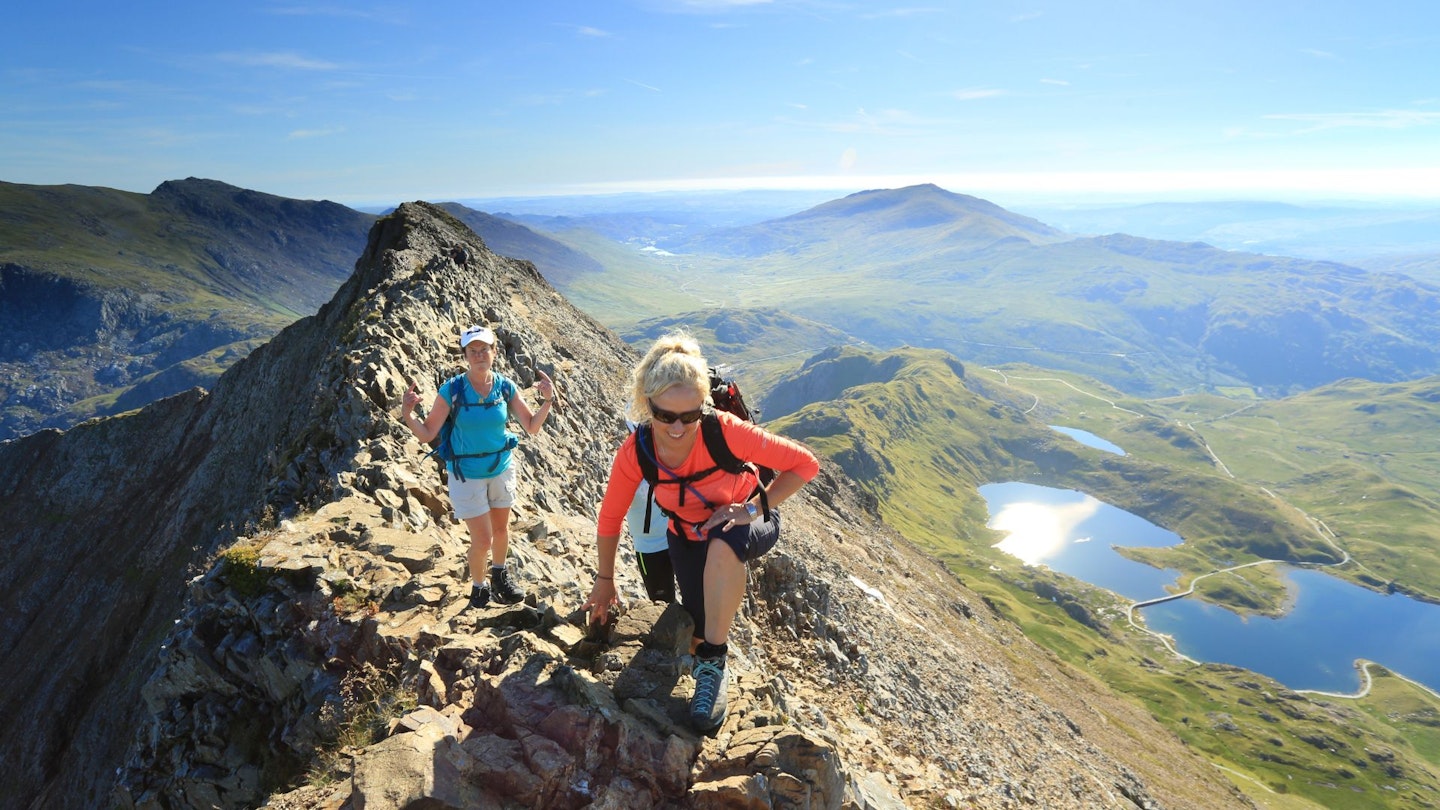
Before you start shopping, consider the type of hiking you'll be doing. Are you planning short day hikes on well-maintained trails, or are you tackling long, rugged mountain treks? Different hikes require different features.
For light hiking on easy woodland trails, look for lightweight shoes with moderate support. For longer day hikes on varied terrain, opt for shoes with better ankle support and a good amount of cushioning on the midsole. If you’re backpacking on multi-day hikes with a heavy backpack, choose shoes with excellent support, durability, and stability over a pair of flimsier trail shoes.
Fit and Comfort
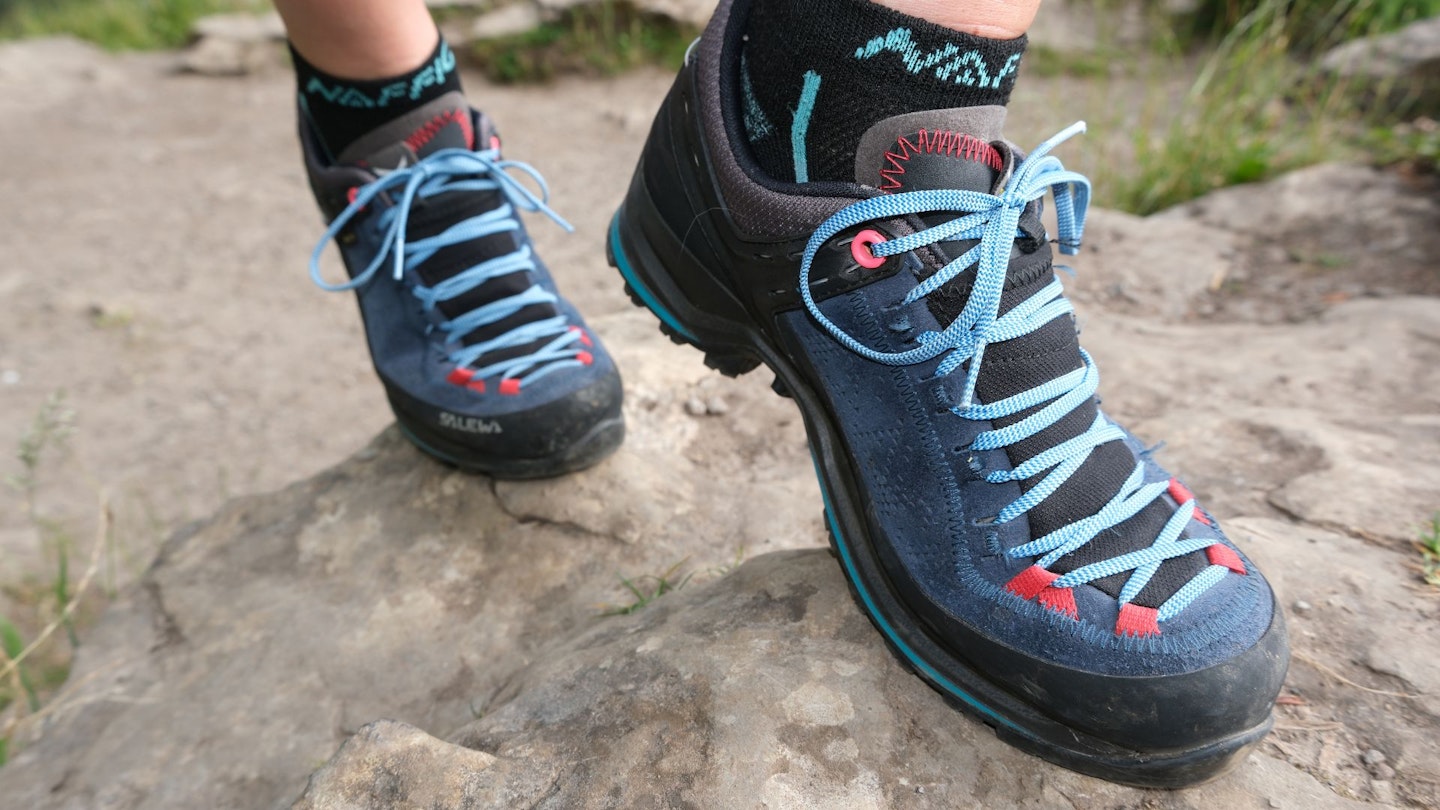
A proper fit is essential to prevent blisters and general foot misalignment, which can have consequences for ankles, knees and hips further down the line. When considering fit, ensure there is about a thumb's width between your toes and the end of the shoe, which allows for swelling during exercise and in hot weather.
Your foot should not be squeezed at any point, especially not at the toes as that's a fast way of getting horrible blisters on your pinkies. Arch support should match your foot’s arch type, whether low, neutral, or high - definitely consider insoles to help with this if you need to. It's best to try shoes on in the afternoon when your feet are naturally swollen, and wear the socks you plan to hike in for the most accurate fit.
Material
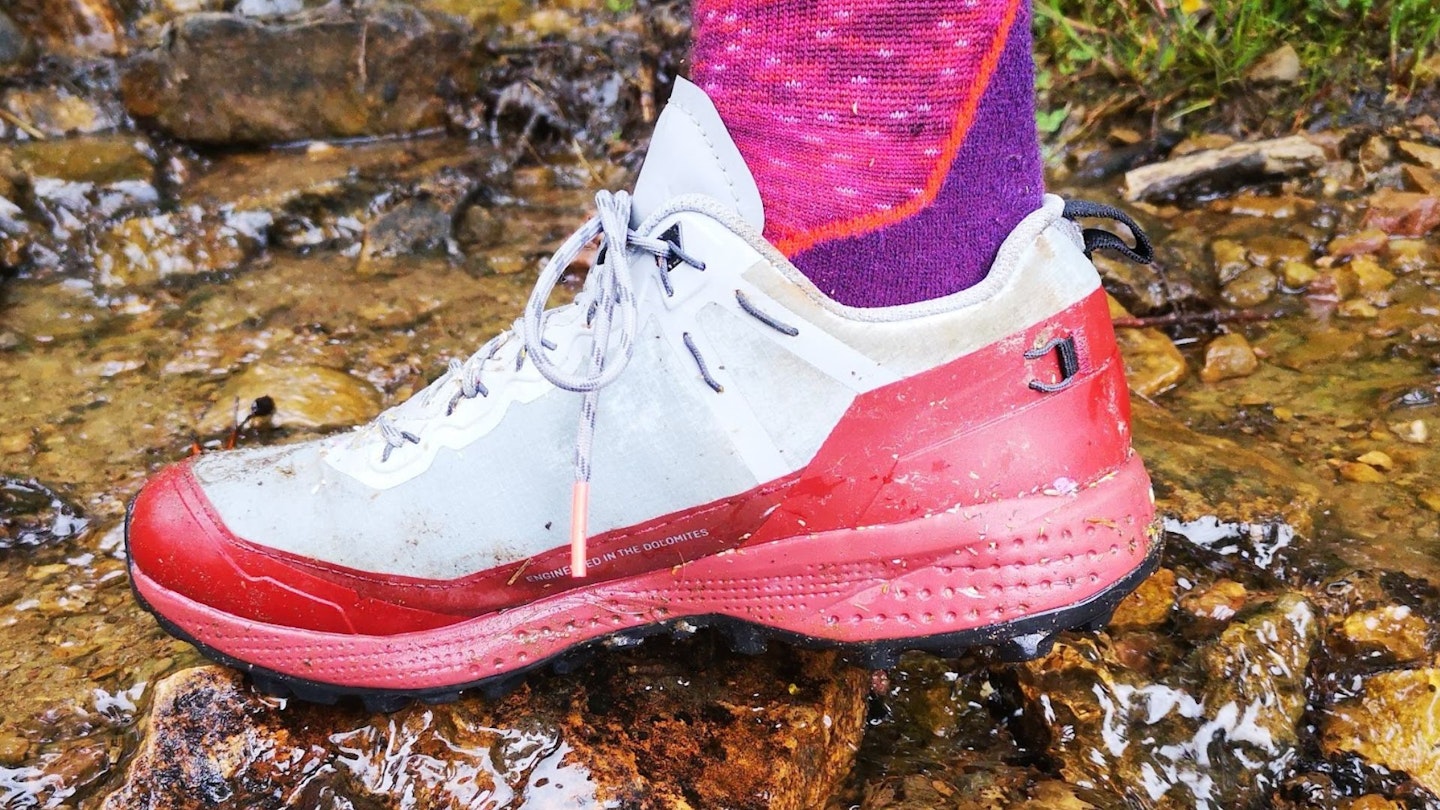
The material of the shoe affects its weight, breathability, and water resistance. Leather offers excellent durability and support but tends to be heavier and less breathable. Synthetic materials are generally lighter and more breathable, but less durable and can contribute to microplastic pollution on the hill as they wear out over time. Waterproof membranes like Gore-Tex keep water out but can reduce breathability, making them suitable for wet conditions but potentially less comfortable in hot, dry environments.
Weight
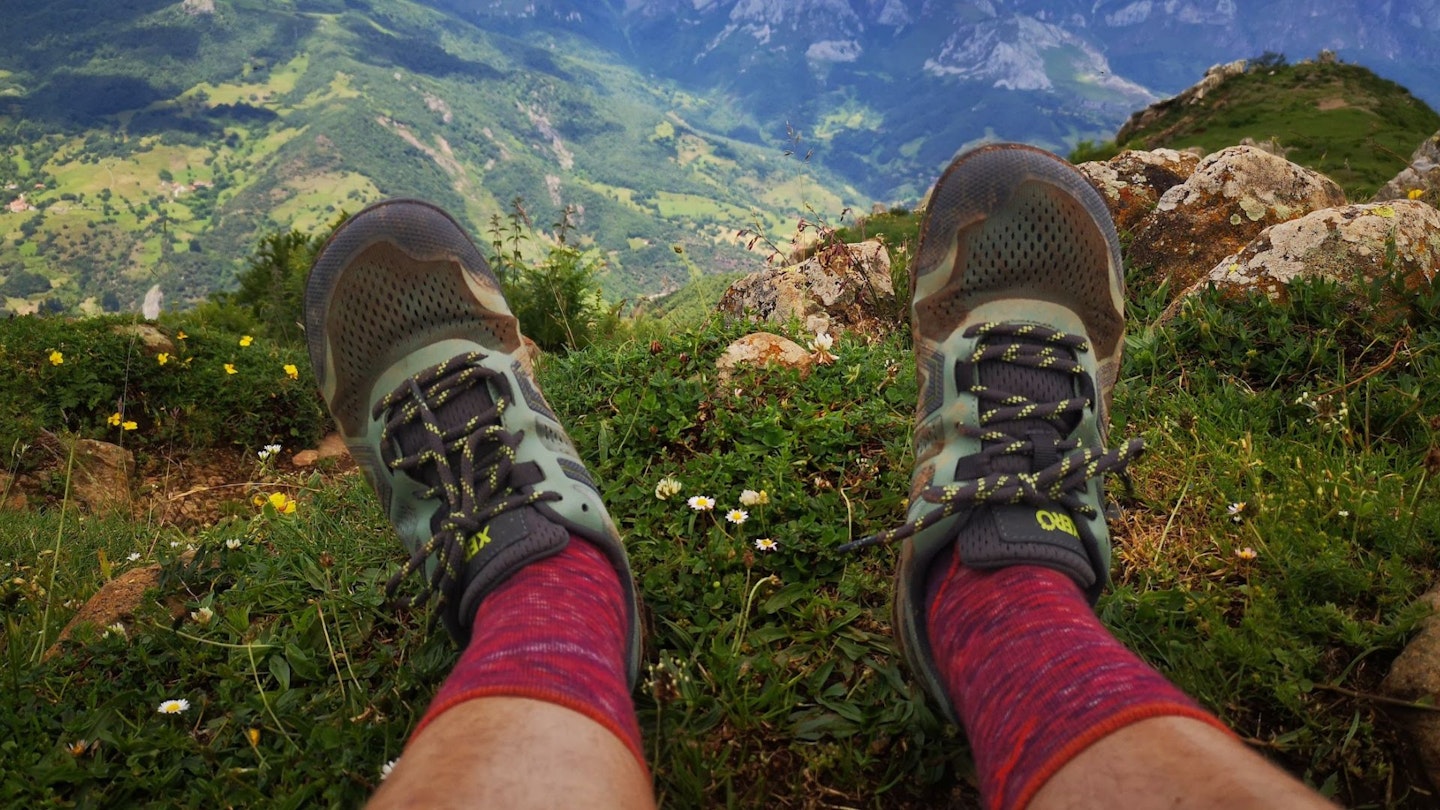
The weight of your hiking shoe impacts your energy expenditure - but it's not always a case of "the lighter, the better". Lighter shoes can reduce fatigue but might offer less support and durability on rockier or more undulating trails. Heavier shoes provide better support and protection but can be cumbersome, especially over short distances where they're not needed. Consider whether you're looking for a direct boot replacement, in which case you'll want something slightly on the beefier end of the spectrum, or if you're after a lighter more trainer-ish shoe for shorter, less demanding walking.
Support and cushioning
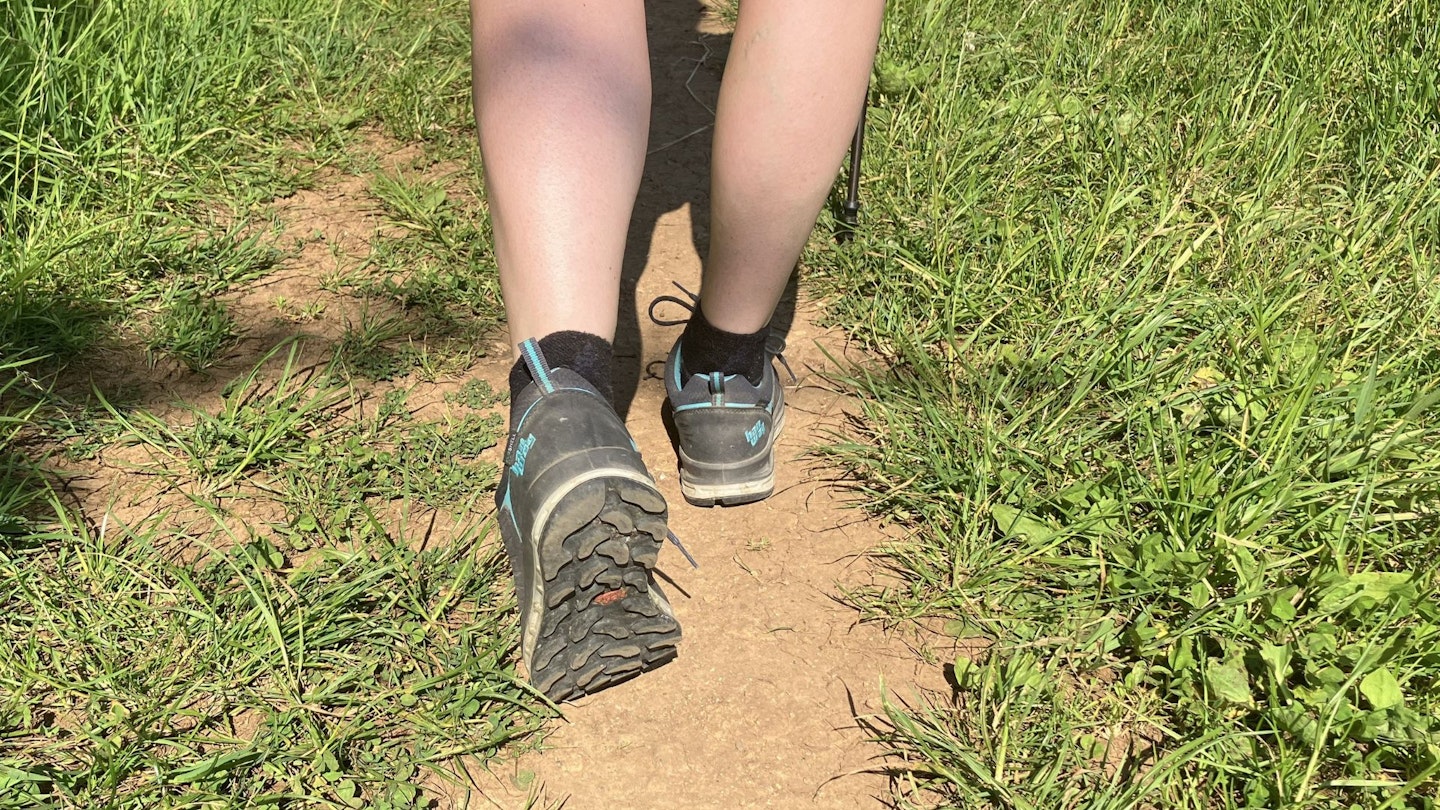
Good support and cushioning help absorb shock and reduce strain on your feet and legs (if you're not a hardcore minimalist like LFTO writer Fliss Freeborn). Midsoles made of EVA (ethylene vinyl acetate) are lighter and cushier, while PU (polyurethane) midsoles are firmer and more durable. Durable rubber outsoles with deep lugs offer better grip on varied terrain, ensuring stability and traction.
Durability
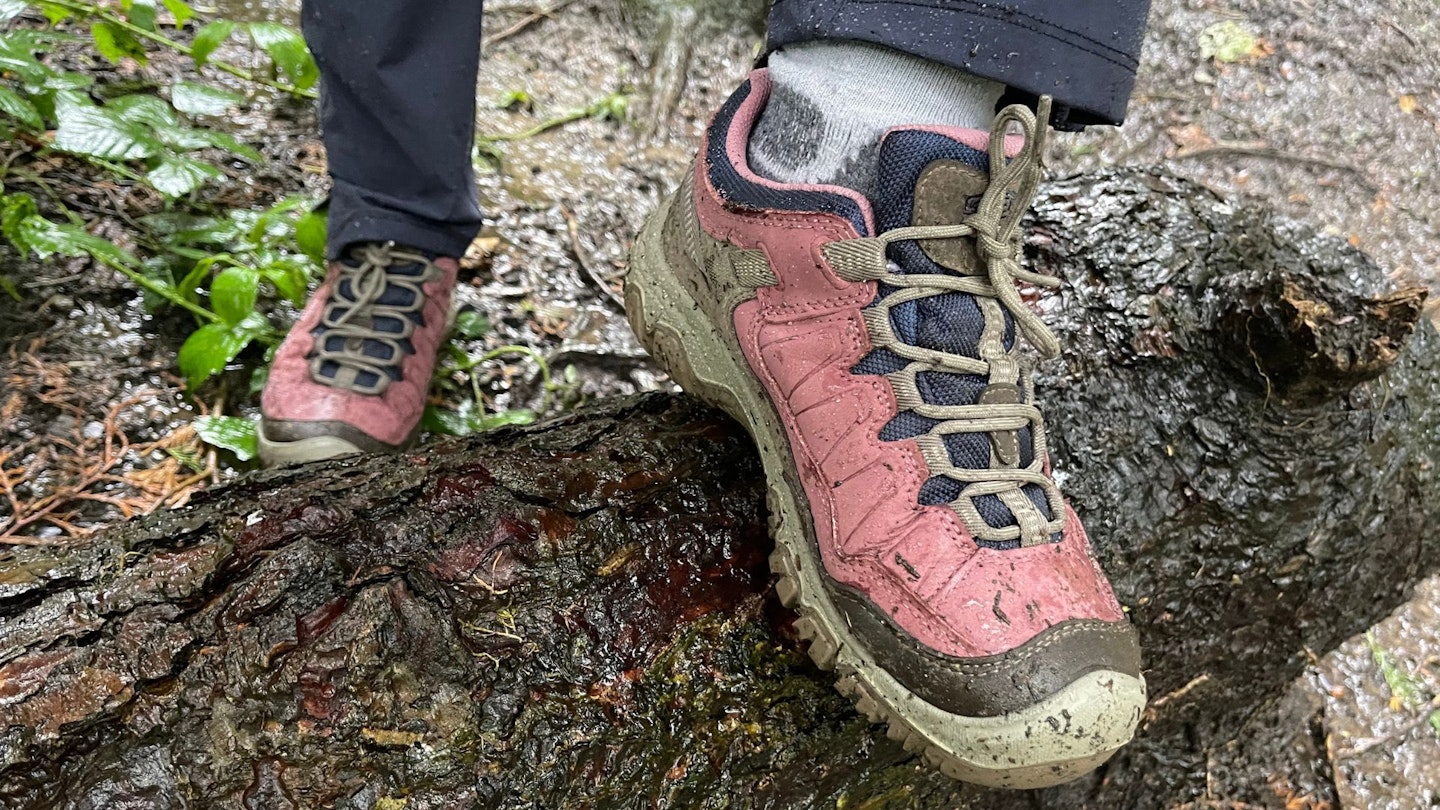
Durability is key for a long-lasting hiking shoe which won’t fall apart 50 miles in. Look for shoes with reinforced toe caps, sturdy stitching, and durable materials such as ripstop weaves. These features contribute to the shoe’s ability to withstand rough conditions and extend its lifespan, making it better for the environment too.
Breathability
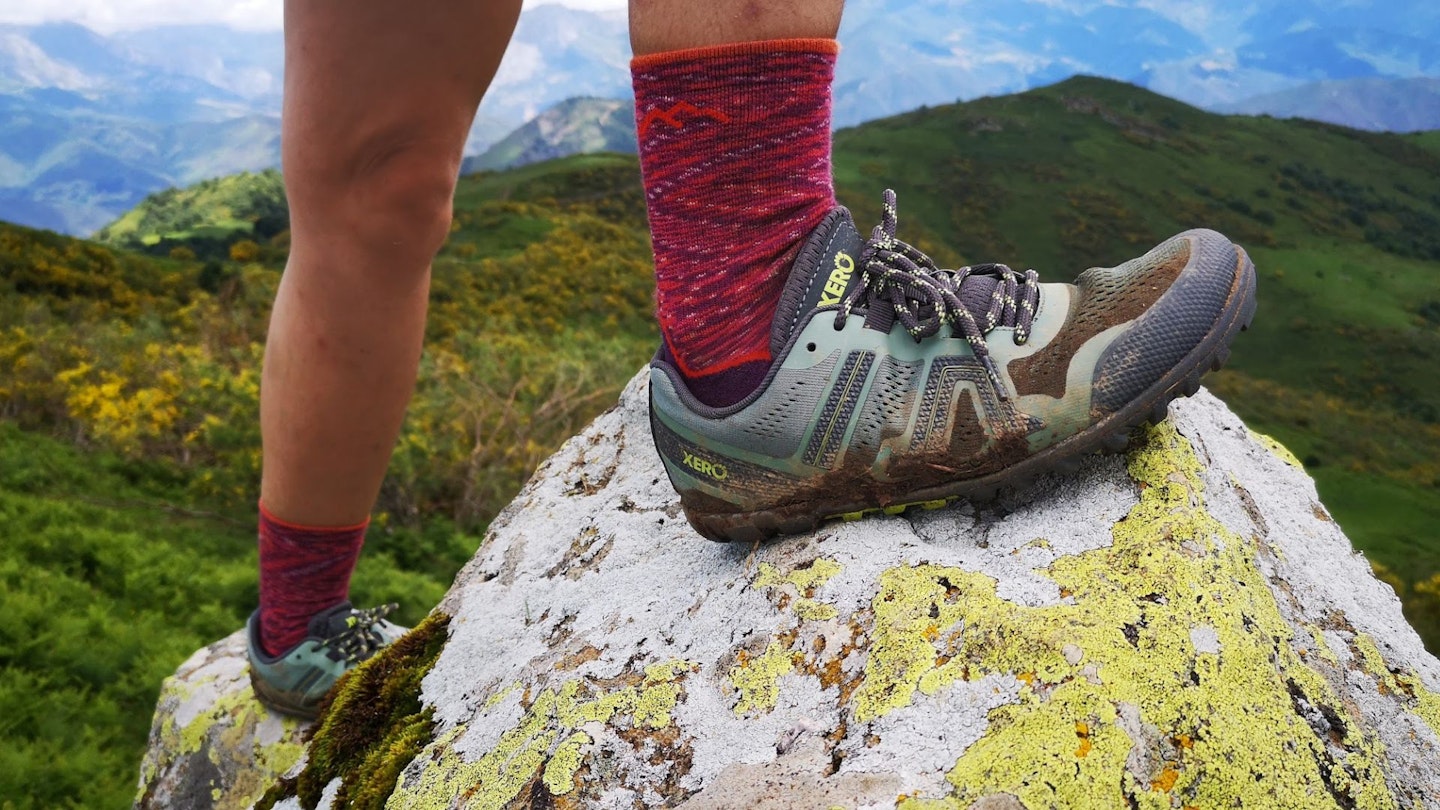
Breathability is crucial if you hike in hot conditions or are a self-proclaimed sweaty betty. Shoes with breathable materials, such as mesh panelling help keep your feet cool and dry, wicking moisture away rather than it pooling up in a hot, sticky mess between your toes.
Water Resistance
For wet or muddy conditions, waterproof shoes with a Gore-Tex membrane or similar technology are essential if you fancy keeping your feet dry. However, it’s important to note that waterproof shoes might be less breathable on warmer days. If you hike mainly in dry conditions, you might prioritise breathability over waterproofing - esepcially if you're happy just to get your feet wet from time to time.
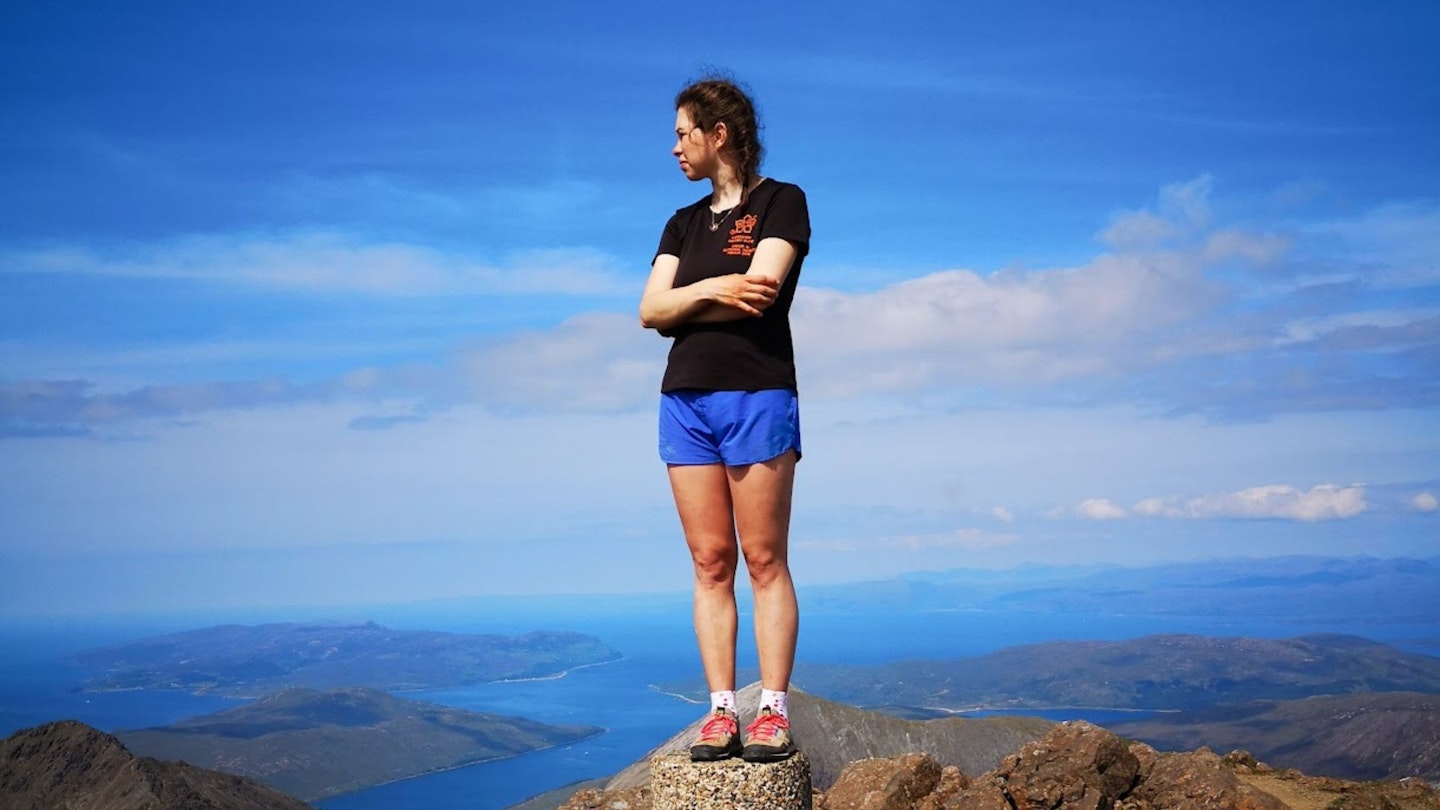
Price
You can spend as much or as little as you like on a pair of hiking shoes. Budget-friendly options start from £30-60, and the range continues into high-end models which can soar well over the £150 mark. While it’s tempting to go for cheaper footwear, investing in a quality pair often pays off in terms of comfort, support, and durability. Higher-priced shoes typically offer better materials, construction, and features that make your hiking experience far more enjoyable - but you can often find last year's shoes on sale from retailers at a hefty discounted prices, giving you the best of both worlds.
About the Author
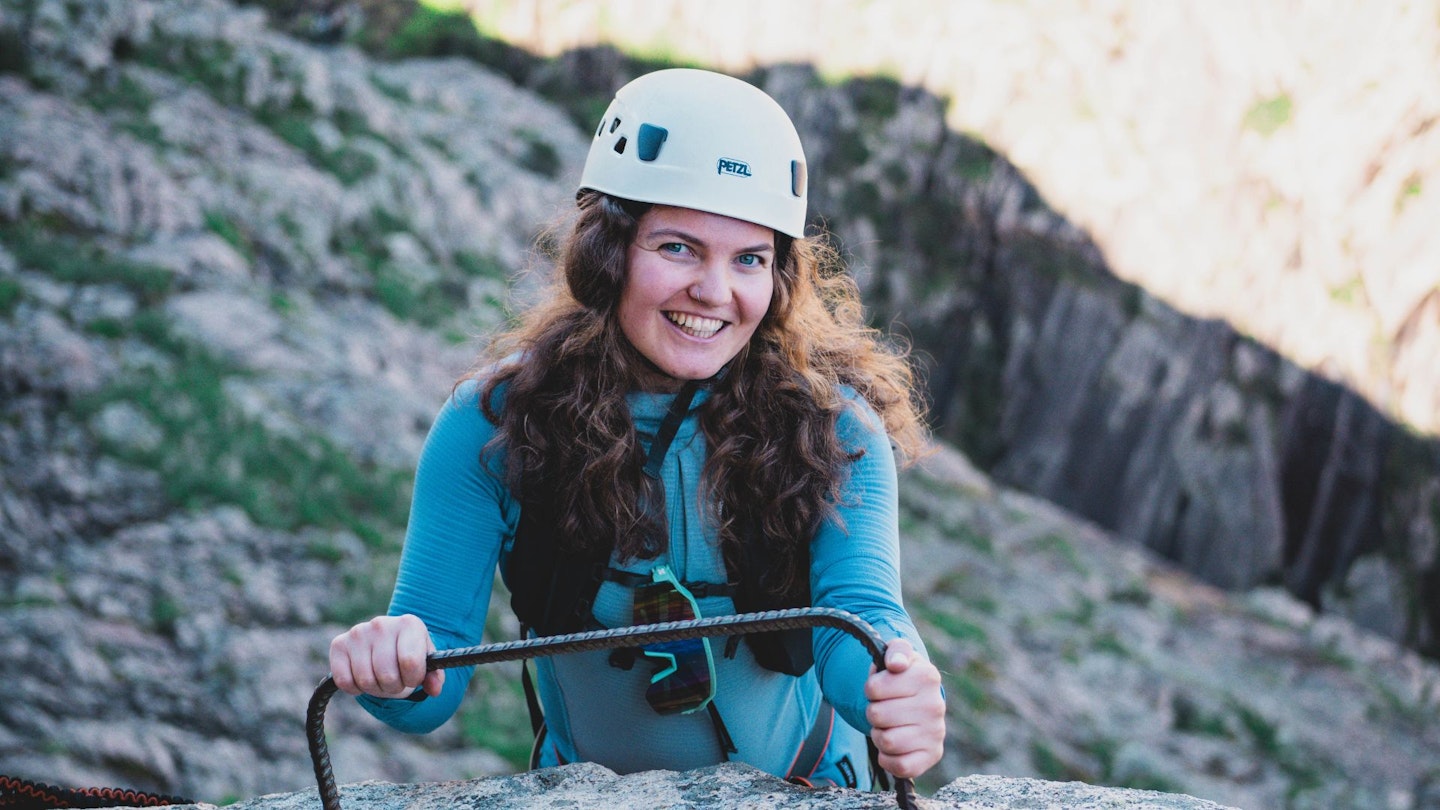
LFTO writer Fliss Freeborn compiled this piece using her own testing experience and that of the other female LFTO team. Fliss is usually found cooking a succulent meal halfway up a mountain, or cooking a succulent meal on a beach. She has also cooked many succulent meals in Forestry Commission car parks. She prefers hiking shoes to boots for almost all activities, including cooking succulent meals.









